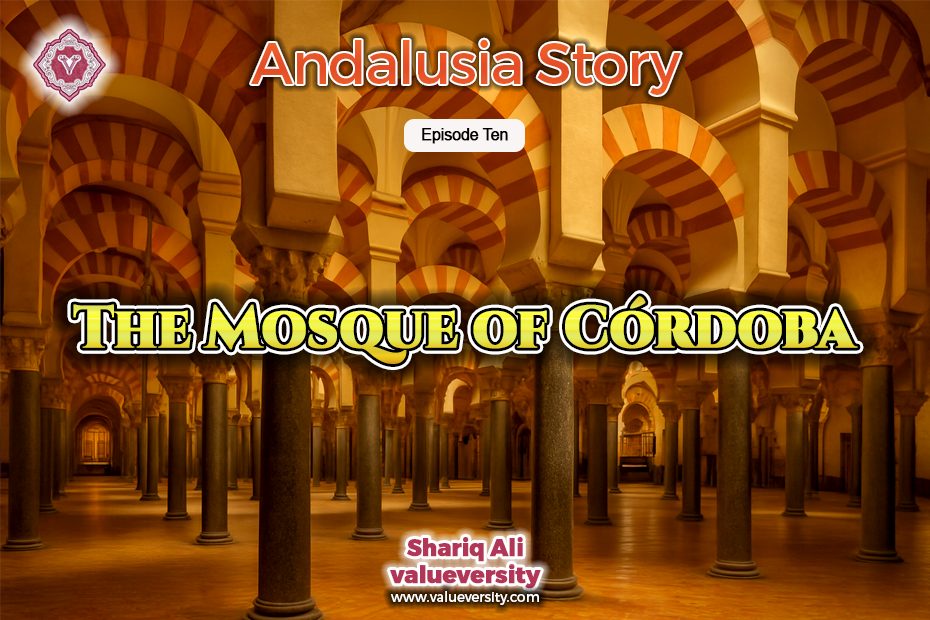The Mosque of Córdoba، Andalusia Chronicles، Episode 10
✍️ Shariq Ali
Valueversity
We were standing beside the outer wall of the mosque, waiting for our guide Pedro. Once he had shown the group ticket to the authorities, we all entered the inner part of the mosque together. He then gave us time to explore the mosque independently and told us to meet again later at the outer gate.
When Abd al-Rahman I made Córdoba the capital of his newly established Umayyad rule, he dreamed of a mosque that would not only serve as a place of worship but also stand as a lasting symbol of his cultural identity. The story of the site where the Mosque of Córdoba stands today is centuries old.
It is said that originally, a Roman temple once stood here, dedicated to the worship of the sun god. Time buried its remnants, and in later eras, the Christians built a Gothic church at the same spot, known as San Vicente.
Abd al-Rahman I purchased part of this land and acquired the rest through state authority, laying the foundation of the mosque in 784 AD.
It is said that the construction of the mosque cost around 80,000 dirhams—a significant sum in that era. The first phase of construction was completed within two years.
Abd al-Rahman I had deep devotion to this mosque. It is said that he personally supervised the construction, even involving himself in the arrangement of the columns, the shape of the arches, and the selection of marble. His dream was to create a space that would offer spiritual tranquility.
As soon as we entered the courtyard of the mosque, we were met by a sea of columns—856 in total. Made of marble, granite, and gypsum, they stood in symmetrical rows as if silently engaged in prayer. Above them, a web of double arches, so intricate that the eye struggled to follow. Each arch, with its curved forehead, resembled a framed reflection of a palm tree.
This “palm-grove architectural style” was inspired by the landscapes of Syria—the same land where Abd al-Rahman spent his childhood. Each horseshoe-shaped arch and stone column seemed to echo the memories of a lost homeland.
The brilliance of the architecture lay in its mastery of light and shadow. It felt as if nature itself had arranged it. The high ceilings and airy skylights kept the atmosphere fresh at all times—no sense of suffocation, no noise. Just a spiritual resonance that must have filled hearts as the call to prayer echoed.
The atmosphere of the mosque held a quiet reverence that transcended religious boundaries.
While wandering through various sections, we reached the spot where Abd al-Rahman I used to lead the dawn prayer, arriving via a secret underground passage from his palace.
We stood beside the marble pulpit, a living example of Islamic architecture. Behind it, Quranic verses were engraved on the dome—though some had been erased at various points in time.
The pulpit itself was elevated and well-lit, visible from all angles. This was likely the very place where Abd al-Rahman would appear through the hidden passage, lead the prayer, and then quietly return.
When Muslim rule ended in Córdoba and later in Granada, the Christians took control of the city in 1236. From that point, changes to the mosque began. Initially, Christian elements were added within the existing mosque boundaries. Then, in the 16th century, a grand Gothic cathedral was constructed in the center of the mosque. The place that once awakened to the call of the muezzin now echoed with church bells.
As we wandered through the mosque, Christian architecture was visible in some parts, while Islamic remnants stood firm in others—a game of cultural hide-and-seek under one roof that had continued for centuries.
Eventually, we reached the cathedral built right in the heart of the mosque. Constructed in 1523 during the reign of Charles V, the Holy Roman Emperor, it is said that even Charles later expressed regret over the decision.
The architectural style of this cathedral is a stunning blend of Gothic, Renaissance, and Baroque. Inside, it boasts tall arches, magnificent columns, colorful stained-glass windows, and Christian symbols carved into wood—creating a striking, yet strangely harmonious contrast with the Islamic elements of the mosque.
The cathedral remains an active place of worship today, transforming this grand structure into a monument of intercultural legacy.
We spent nearly two hours exploring this magical building. Finally, we exited through another gate on the opposite side of the courtyard…
(To be continued)
